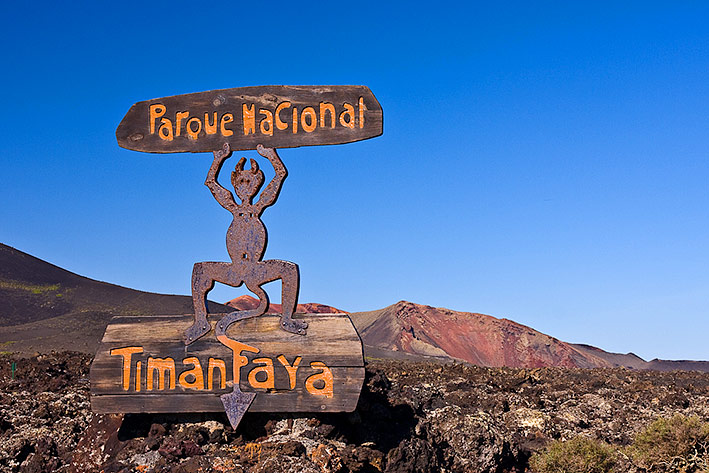As with the other Canary Islands, Lanzarote is Volcanic in origin. Due to the recent eruptions in the 18th and 19th Centuries, many parts of Lanzarote appear to be from another world, often described as 'lunar' or 'Martian', so much so that parts of 'Planet of the Apes' were shot here. The dry climate (and lack of erosion) means that the Volcanic Landscape appears much as it did just after the eruptions.
Amongst the many stunning Volcanic features of Lanzarote is the longest Volcanic Tunnel in the world, Cueva de los Verdes, which is over 7 km long.
Despite the Volcanic nature of the island, Lanzarote has several beautiful white beaches such as at Playa Blanca and Papagayo.
Local authority regulations on the amount and style of development mean that there is no billboard advertising and no high rise buildings in Lanzarote (with the exception of the Grand Hotel in Arrecife).
Lanzarote is the most easterly of the seven major Canary Islands and lies in the Atlantic Ocean only some 100 km (60 miles) from the coast of Africa and 1,000 km from the Iberian Peninsula. The island enjoys an average temperature of 22 degrees Centigrade all year-round due to its advantageous location in the Tropic of Cancer

In 1993, the island of Lanzarote was declared a Biosphere Reserve as it conserves one of the most exceptional ecosystems and volcanic landscapes in the archipelago. Lanzarote has a great wealth of native plants, such as Timanfaya seed and the Famara plantain which are both exclusive to Lanzarote. As far as the invertebrate fauna are concerned, there are a large number of endemic species, some of which have special features due to their adaptation to their surroundings, such as a cricket that lives in holes in the lava and the Blind Albino Crab of the Jameos del Agua. Birds find refuge in the "Chinijo Archipelago" (the small islands to the north of Lanzarote) where several threatened species live (Osprey, Falcons, Petrels, Shearwaters etc.) and in the arid zones where the Houbara Bustard, the Cream-Coloured Courser or the Stone Curlew are found. Two reptiles to look out for are the Atlantic Lizard and the Fuerteventura Salamander. Among the mammals, special mention should be given to the endemic Canary shrew (Crocidura canariensis). The waters around Lanzarote support a large and varied population of marine species. Fish such as Barracuda, Grouper and Stingray frequent the reefs around the coast, while Hammerhead Sharks are found around the island of Los Lobos. Whales, Dolphins, Turtles and Flying Fish can often be seen during a Ferry Crossing or Boat Trip.
Arrecife is the political and commercial capital and home to half of the island’s population. Five minutes away is the international airport with its daily flights to the other Canary Islands as well as to mainland Spain and continental Europe.
Lanzarote, including the small islands of La Graciosa, Alegranza, Montaña Clara, Roque del Este y del Oeste, covers 900 km² running 60 km north to south and only 20 km at its widest point.
Lanzarote is made up of seven municipalities: Arrecife (the capital), Teguise, Haría, San Bartolomé, Tías, Tinajo and Yaiza, with an official population of nearly 100,000 inhabitants, mostly residing in the south-central part of the island.
The island was named after a Genoese navigator called Lancelotto Malocello who arrived on the island during the second half of the XIV century opening the way to successive expeditions of French, British and Spanish sailors and merchants. Previously the isles were known as the Fortunate Islands.
Fishing and agriculture once formed the basis of the island’s economy but have since been overtaken by the excellent quality of its tourism industry.
Amongst the most outstanding attractions are the Art, Culture and Tourist Centres run under the auspices of the Insular Council. The world famous artist César Manrique's sensitive response to Lanzarote´s unique geography and people was instrumental in creating a pervasive artistic identity throughout the island.
Great care has been taken in preserving its historical and artistic heritage, its monuments and characteristic houses, local festivals and customs... in short, the full expression of its culture and folklore.
The tranquil fishing village of Playa Blanca is situated on the southern tip of the island which takes its name from the white sands of its sun-drenched beaches. Like other places on the island, this quiet unspoiled resort has been sympathetically developed so that the centre of the town has retained much of its original fishing village charm. There is a large selection of shops and supermarkets and many excellent restaurants.
Playa Blanca also boasts some superb very shallow beaches which are perfect for small children. In addition, the Papagayo beaches, which are some of the most beautiful in the Canaries, are only a few minutes drive away. Playa Blanca is the quietest, warmest and flattest of the three principle resorts on Lanzarote and is therefore particularly attractive to slightly older visitors and the very youngest.

Timanfaya National Park, Lanzarote is of volcanic origin and literally covered in lava.

The island of La Graciosa in the North, viewed from the cliffs at Mirador del Rio.